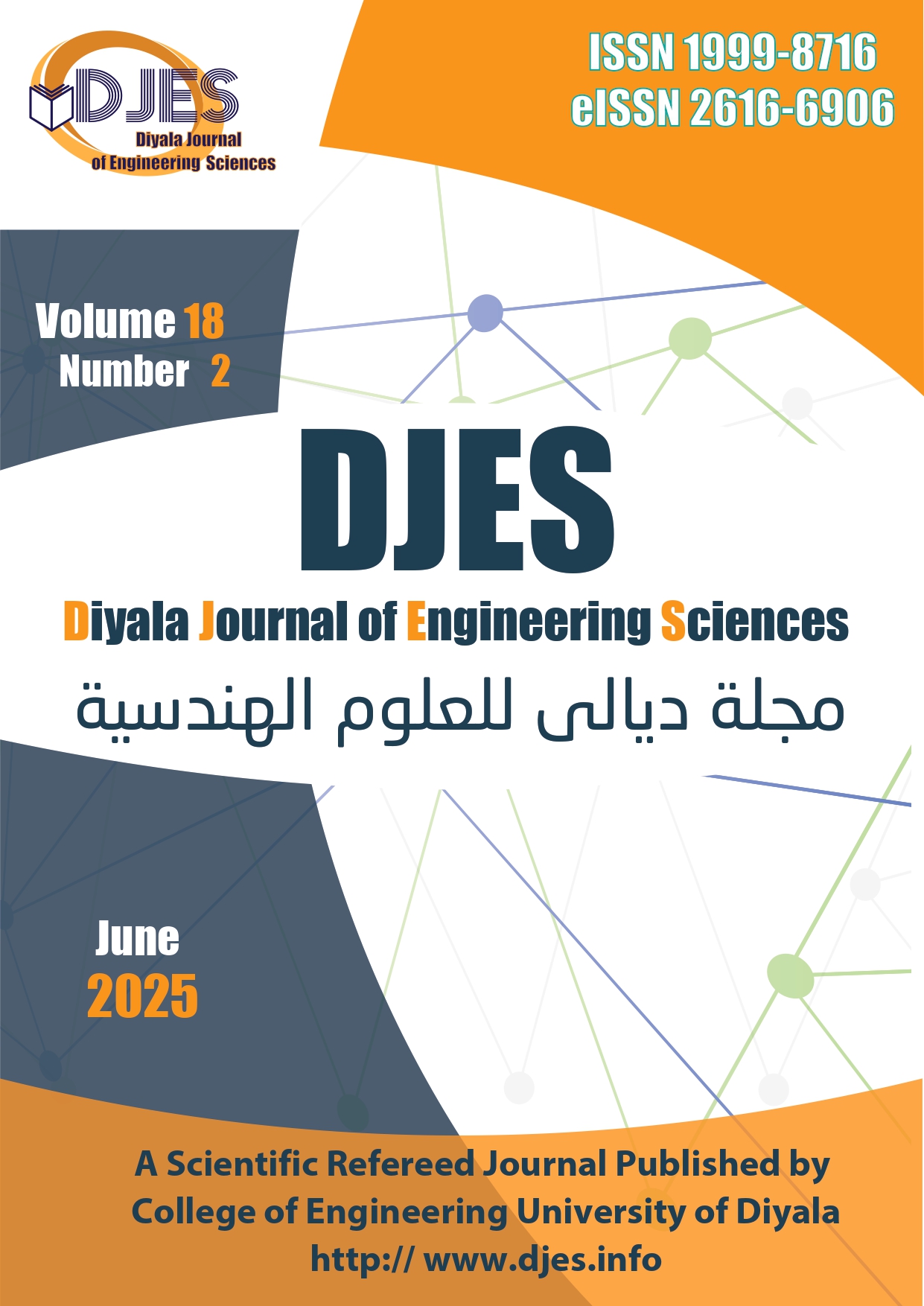An EEG Dataset for Alzheimer’s Disease Patients in Iraq: Electrophysiological Recordings Across Cognitive Stages
DOI:
https://doi.org/10.24237/djes.2024.18203Keywords:
Alzheimer’s Disease , EEG, Machine Learning, Deep Learning, AD DatasetAbstract
Alzheimer's disease (AD) is one of the common neurodegenerative disorders presenting with progressive cognitive decline and synaptic impairment. The need for accurate and accessible diagnostic methods is especially pressing in resource-limited regions. This study presents the first open electroencephalography (EEG) dataset for Alzheimer's Disease (AD) in Iraq, recording electrophysiological activity in four stages of cognition, namely, Healthy, Mild, Moderate, and Severe. The dataset comprised recordings from 53 participants and was recorded using a 40-channel EEG device based on the 10-20 electrode placement standard. Considering this EEG dataset, advanced preprocessing, such as the removal of artifacts, Independent Component Analysis (ICA), and Automatic Subspace Reconstruction (ASR), was performed to ensure high signal quality suitable for all state-of-the-art Machine Learning (ML) and Deep Learning (DL) analyses. Benchmark classification was conducted with a wide variety of ML and DL models, including Random Forest (RF), Gradient Boosting methods, Support Vector Machines (SVM), Convolutional Neural Networks (CNNs), and Long Short-Term Memory networks (LSTMs), showing promising results-a maximum of 96.85% by Random Forest within ML techniques and a maximum of 96.05% by DNNs in DL techniques. This dataset fills a critical gap in regional AD research and moves toward developing low-cost, noninvasive diagnostic tools. Future work may be performed on more extended and more diverse datasets with more sophisticated multimodal approaches for improving AD diagnosis and early intervention. The dataset can be downloaded from https://shorturl.at/Z0b8D.
Downloads
References
[1] A. Miltiadous et al., “Alzheimer’s disease and frontotemporal dementia: A robust classification method of eeg signals and a comparison of validation methods,” Diagnostics, vol. 11, no. 8, 2021, doi: 10.3390/diagnostics11081437.
[2] M. Ouchani, S. Gharibzadeh, M. Jamshidi, and M. Amini, “A Review of Methods of Diagnosis and Complexity Analysis of Alzheimer’s Disease Using EEG Signals,” Biomed Res. Int., vol. 2021, 2021, doi: 10.1155/2021/5425569.
[3] X. Zheng et al., “Diagnosis of Alzheimer’s disease via resting-state EEG: integration of spectrum, complexity, and synchronization signal features,” Front. Aging Neurosci., vol. 15, no. November, pp. 1–9, 2023, doi: 10.3389/fnagi.2023.1288295.
[4] Y. Ma, J. K. S. Bland, and T. Fujinami, “Classification of Alzheimer’s Disease and Frontotemporal Dementia Using Electroencephalography to Quantify Communication between Electrode Pairs,” Diagnostics, vol. 14, no. 19, 2024, doi: 10.3390/diagnostics14192189.
[5] A. Miltiadous et al., “A Dataset of Scalp EEG Recordings of Alzheimer’s Disease, Frontotemporal Dementia and Healthy Subjects from Routine EEG,” Data, vol. 8, no. 6, pp. 1–10, 2023, doi: 10.3390/data8060095.
[6] M. J. Sedghizadeh, H. Aghajan, and Z. Vahabi, “Brain electrophysiological recording during olfactory stimulation in mild cognitive impairment and Alzheimer disease patients: An EEG dataset,” Data Br., vol. 48, 2023, doi: 10.1016/j.dib.2023.109289.
[7] A. M. Pineda, F. M. Ramos, L. E. Betting, and A. S. L. O. Campanharo, “Quantile graphs for EEG-based diagnosis of Alzheimer’s disease,” PLoS One, vol. 15, no. 6, pp. 1–15, 2020, doi: 10.1371/journal.pone.0231169.
[8] K. Smith, D. Abásolo, and J. Escudero, “Accounting for the complex hierarchical topology of EEG phase-based functional connectivity in network binarisation,” PLoS One, vol. 12, no. 10, pp. 1–21, 2017, doi: 10.1371/journal.pone.0186164.
[9] M. Cejnek, O. Vysata, M. Valis, and I. Bukovsky, “Novelty detection-based approach for Alzheimer’s disease and mild cognitive impairment diagnosis from EEG,” Med. Biol. Eng. Comput., vol. 59, no. 11–12, pp. 2287–2296, 2021, doi: 10.1007/s11517-021-02427-6.
[10] M. L. Vicchietti, F. M. Ramos, L. E. Betting, and A. S. L. O. Campanharo, “Computational methods of EEG signals analysis for Alzheimer’s disease classification,” Sci. Rep., vol. 13, no. 1, pp. 1–14, 2023, doi: 10.1038/s41598-023-32664-8.
[11] M. Soufineyestani, D. Dowling, and A. Khan, “Electroencephalography (EEG) technology applications and available devices,” Appl. Sci., vol. 10, no. 21, pp. 1–23, 2020, doi: 10.3390/app10217453.
[12] V. Aspiotis et al., “Assessing Electroencephalography as a Stress Indicator: A VR High-Altitude Scenario Monitored through EEG and ECG,” Sensors, vol. 22, no. 15, pp. 1–16, 2022, doi: 10.3390/s22155792.
[13] F. Duan et al., “Topological Network Analysis of Early Alzheimer’s Disease Based on Resting-State EEG,” IEEE Trans. Neural Syst. Rehabil. Eng., vol. 28, no. 10, pp. 2164–2172, 2020, doi: 10.1109/TNSRE.2020.3014951.
[14] M. M. Hasan, S. Khandaker, N. Sulaiman, M. Mahfuj Hossain, and A. Islam, “Addressing Imbalanced EEG Data for Improved Microsleep Detection: An ADASYN, FFT and LDA-Based Approach,” Diyala J. Eng. Sci., vol. 17, no. 3, pp. 45–57, 2024, doi: 10.24237/djes.2024.17304.
[15] N. Hassan, A. S. M. Miah, and J. Shin, “A Deep Bidirectional LSTM Model Enhanced by Transfer-Learning-Based Feature Extraction for Dynamic Human Activity Recognition,” Appl. Sci., vol. 14, no. 2, 2024, doi: 10.3390/app14020603.
[16] R. Jamal Kolaib and J. Waleed, “Crime Activity Detection in Surveillance Videos Based on Developed Deep Learning Approach,” Diyala J. Eng. Sci., vol. 17, no. 3, pp. 98–114, 2024, doi: 10.24237/djes.2024.17307.
[17] M. Y. Shakor and N. M. S. Surameery, “CNN-Based Transfer Learning for 3D Knuckle Recognition,” Adv. Multimed., vol. 2023, pp. 1–12, 2023, doi: 10.1155/2023/6147422.
[18] V. Ronca et al., “Optimizing EEG Signal Integrity: A Comprehensive Guide to Ocular Artifact Correction,” Bioengineering, vol. 11, no. 10, 2024, doi: 10.3390/bioengineering11101018.
[19] N. M. S. Surameery, A. Alazzawi, and A. T. Asaad, “Intelligent Approaches for Alzheimer ’ s Disease Diagnosis from EEG Signals : Systematic Review,” vol. 17, no. 1, pp. 1–19, 2025.
[20] J. Shi, H. Yan, and Y. Wei, “Application of the denoising technique based on improved FastICA algorithm in cross-correlation time delay estimation,” J. Phys. Conf. Ser., vol. 1754, no. 1, 2021, doi: 10.1088/1742-6596/1754/1/012196.
[21] W. Xia, R. Zhang, X. Zhang, and M. Usman, “A novel method for diagnosing Alzheimer’s disease using deep pyramid CNN based on EEG signals,” Heliyon, vol. 9, no. 4, p. e14858, 2023, doi: 10.1016/j.heliyon.2023.e14858.
[22] M. Velazquez and Y. Lee, “Random forest model for feature-based Alzheimer’s disease conversion prediction from early mild cognitive impairment subjects,” PLoS One, vol. 16, no. 4 April, pp. 1–18, 2021, doi: 10.1371/journal.pone.0244773.
[23] H. Q. Flayyih, J. Waleed, and A. M. Ibrahim, “Indoor Air Quality Prediction in Sick Building Using Machine and Deep Learning: Comparative Analysis,” Diyala J. Eng. Sci., vol. 18, no. 1, pp. 203–218, 2025, doi: 10.24237/djes.2025.18112.
[24] K. AlSharabi, Y. Bin Salamah, M. Aljalal, A. M. Abdurraqeeb, and F. A. Alturki, “EEG-based clinical decision support system for Alzheimer’s disorders diagnosis using EMD and deep learning techniques,” Front. Hum. Neurosci., vol. 17, 2023, doi: 10.3389/fnhum.2023.1190203.
Downloads
Published
Issue
Section
License
Copyright (c) 2025 Nigar M. Shafiq Surameery, Abdulbasit Alazzawi, Aras T. Asaad, Abas Nariman Sidiq Tilako, Sarwer Jamal Al-Bajalan

This work is licensed under a Creative Commons Attribution 4.0 International License.












